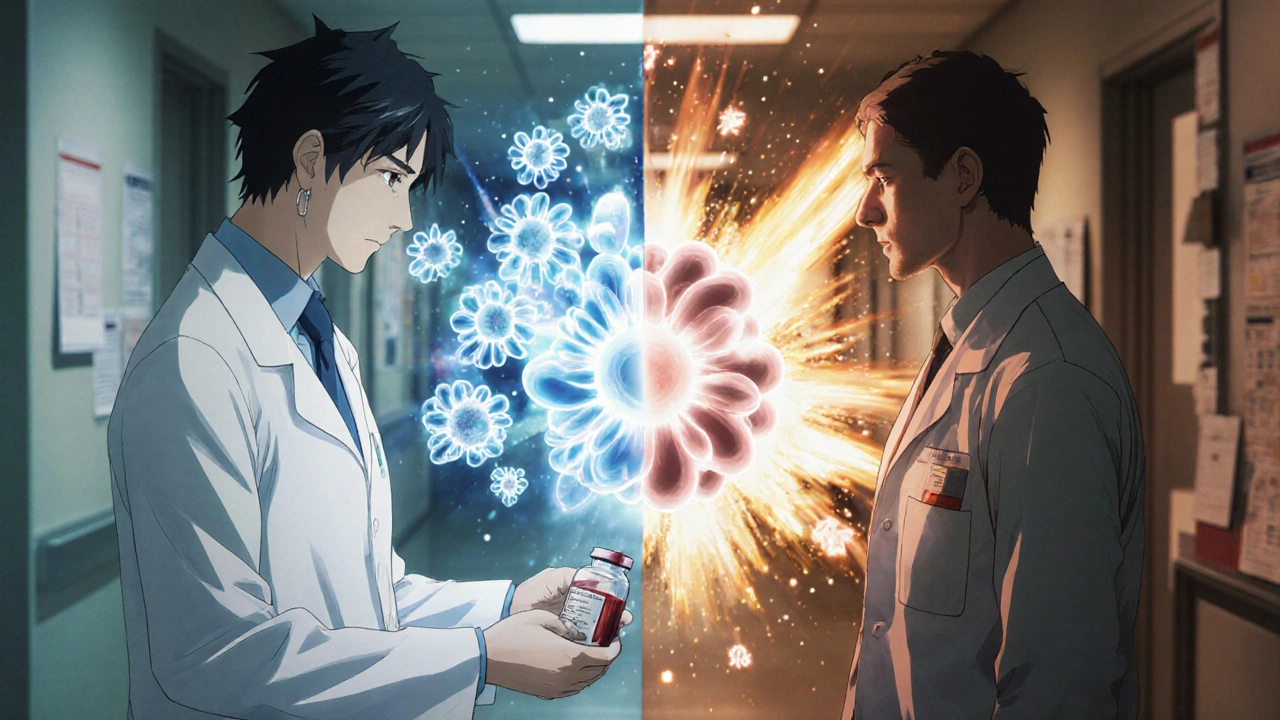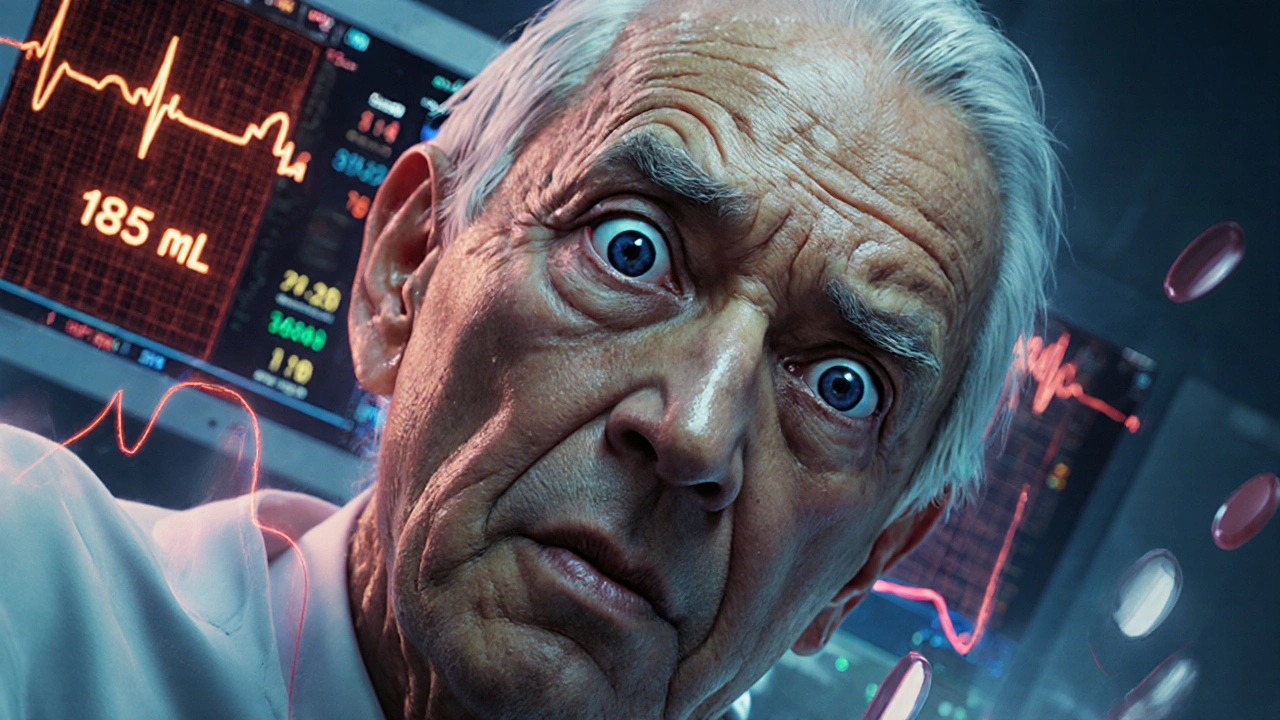TCA Toxicity Risk Calculator
Enter Patient Information
Risk Assessment
Key Risk Factors
Important: TDM results must always be interpreted alongside clinical symptoms. Blood levels alone don't tell the whole story.
Tricyclic antidepressants (TCAs) like amitriptyline and nortriptyline can save lives - but one wrong dose can end them. These drugs, first introduced in the 1950s, still work for treatment-resistant depression and chronic nerve pain. But they don’t play nice. A single extra pill can push someone into cardiac arrest. That’s why therapeutic drug monitoring isn’t optional - it’s a lifeline.
Why TCAs Are So Dangerous
TCAs have one of the narrowest therapeutic windows of any psychiatric medication. The difference between a helpful dose and a deadly one is small. For amitriptyline, the safe range is 80-200 ng/mL. Go above 500 ng/mL, and you’re in emergency territory. At that level, the heart’s electrical system starts to misfire. QRS complexes on an ECG widen past 100 milliseconds. QT intervals stretch. Torsades de pointes, a deadly arrhythmia, can strike without warning. It’s not just the heart. TCAs block multiple receptors: serotonin, histamine, muscarinic, and alpha-adrenergic. That’s why overdose symptoms include dry mouth, blurred vision, urinary retention, confusion, seizures, and coma. Even patients taking their prescribed dose can slip into toxicity - especially if they’re elderly, have liver problems, or are on other medications that interfere with metabolism.How Therapeutic Drug Monitoring Works
Therapeutic drug monitoring (TDM) means measuring the actual amount of drug in your blood. It’s not guesswork. It’s science. For TCAs, blood is drawn right before the next dose - called a trough level. This gives the most accurate picture of steady-state concentration. It takes about 5-7 days of consistent dosing to reach that state. Draw blood too early, and the numbers mean nothing. The lab uses high-performance liquid chromatography (HPLC) or mass spectrometry to detect levels of the parent drug and its metabolites. For example:- Amitriptyline: 80-200 ng/mL
- Nortriptyline: 50-150 ng/mL
- Desipramine: 100-300 ng/mL
When TDM Saves Lives
A 72-year-old man on 150 mg of nortriptyline for depression starts feeling dizzy and confused. His doctor doesn’t just up the dose because he’s "not responding." He orders a TDM test. Result: 185 ng/mL - above the 150 ng/mL ceiling. The dose is cut in half. Within days, his confusion clears. His ECG normalizes. He avoids ICU admission. That’s not hypothetical. It happened at Johns Hopkins. And it’s not rare. Studies show that using TDM to guide dosing reduces hospitalizations by 35% compared to adjusting doses based on symptoms alone. In elderly patients - who make up 40% of TCA users - TDM cuts the risk of severe side effects by nearly half. Older adults metabolize drugs slower. Their kidneys and livers don’t clear toxins as efficiently. A dose that’s fine for a 30-year-old can be lethal for a 70-year-old.
The Hidden Risks: Genetics and Drug Interactions
Not everyone breaks down TCAs the same way. That’s because of CYP2D6 and CYP2C19 enzymes. These are the liver’s workhorses for metabolizing TCAs. But genetics matter. Some people are poor metabolizers - their enzymes barely work. They build up toxic levels even on low doses. Others are ultrarapid metabolizers - they clear the drug too fast, so it never reaches therapeutic levels. The difference in blood concentration between these two groups can be 20 to 30 times. Add in common medications like fluoxetine, paroxetine, or even some heart drugs, and you’ve got a recipe for disaster. These drugs block CYP2D6, causing TCA levels to spike. A patient on 75 mg of amitriptyline might suddenly hit 400 ng/mL after starting a new antibiotic - without any change in their own behavior. That’s why TDM isn’t just about the number. It’s about context: What else are they taking? What’s their age? Do they have liver disease? Are they compliant?What TDM Can’t Do
TDM isn’t magic. It has limits. First, results take 24-48 hours. In acute overdose, you can’t wait. If someone’s QRS is over 100 ms, you give sodium bicarbonate immediately - no test needed. TDM is for prevention, not rescue. Second, some patients show toxicity even at "therapeutic" levels. One case study described a woman with a 190 ng/mL amitriptyline level - right in the middle of the range - who developed a QRS of 140 ms. Her body was just more sensitive. That’s why TDM must always be paired with clinical observation. Blood levels tell you what’s in the blood. The patient tells you what’s happening to their body. Third, labs don’t always agree. Reference ranges vary by 15-20% between institutions. One lab says 180 ng/mL is safe. Another says it’s borderline toxic. Clinicians need to know which range their lab uses. And here’s the kicker: 32% of TDM requests lack the basic info needed to interpret them - like the exact dose, timing of last dose, or other medications. Without that, the test is useless.
Who Needs TDM the Most
Not everyone on TCAs needs regular blood tests. But these groups absolutely do:- Elderly patients (65+)
- Patients with liver or kidney disease
- Those on multiple medications
- People who haven’t responded to standard doses
- Those with a history of overdose or cardiac issues


April Liu
October 30, 2025 AT 00:25I’ve seen this firsthand with my grandma. She was on nortriptyline for years, and one day she started wandering around confused, muttering to herself. The doctor didn’t think much of it at first - ‘just aging,’ they said. But when we pushed for a TDM test, her level was 187 ng/mL. They cut the dose, and within a week she was back to herself. I’ll never forget how scared we were. TDM isn’t just ‘good practice’ - it’s family safety.
Emily Gibson
October 30, 2025 AT 03:11So many people think antidepressants are just ‘mood boosters’ like coffee. But TCAs? They’re more like surgical tools - precise, powerful, and if you slip, you cut something vital. I work in a geriatric clinic, and I’ve seen three near-overdoses in the last year alone. All avoidable. All because someone skipped the blood test because ‘they felt fine.’
It’s not about distrust. It’s about respect - for the drug, for the body, for life.
Mirian Ramirez
October 31, 2025 AT 17:07Okay so i just wanna say i read this whole thing and i think its so important like i had a friend who took amitriptyline and got hospitalized because he was also on cipro and no one told him not to mix them and his levels went crazy like 450 ng/ml and he had seizures and i just… i dont know how people dont get this. like its not hard to do a blood test and its not expensive and its not a hassle its literally just a needle and a few hours of waiting and it could save your life or your moms life or your grandpas life. also i think the part about cyp2d6 is like the most underrated thing ever like why dont we just test everyone before prescribing? like why are we still guessing? we have the tech. we have the data. we just need to use it. also i think the handheld device thing is gonna change everything like imagine if you could just get a reading before you take your pill like a glucose monitor for your brain. i mean. wow.
Herbert Lui
October 31, 2025 AT 20:52There’s something almost poetic about it - a drug designed to heal the mind, quietly poisoning the heart unless watched like a hawk.
We treat depression like a glitch in the software. But the body? It’s not code. It’s biology with memory, with quirks, with generations of genetic whispers in every enzyme. A CYP2D6 mutation isn’t a ‘side effect’ - it’s a silent inheritance. A legacy written in nucleotides.
TDM isn’t bureaucracy. It’s humility. It’s admitting we don’t fully understand the machine we’re tinkering with - and that’s okay. As long as we’re paying attention.
Nick Zararis
November 2, 2025 AT 02:12Let me just say this: if you’re prescribing TCAs - and you’re not doing TDM - you’re not a doctor. You’re a gambler. With people’s lives. And if your lab doesn’t have a clear reference range? You’re not even playing the game right - you’re rolling dice in the dark.
And if your patient is on fluoxetine? You’re playing Russian roulette with a loaded gun. And you’re not even telling them.
Stop. Just stop. Do the test. Document the meds. Know the metabolizer status. Or don’t write the script.
It’s not complicated. It’s just inconvenient. And convenience shouldn’t trump safety.
Period.
Sara Mörtsell
November 2, 2025 AT 17:44Who even decided TCAs were a good idea? We’re still using 1950s drugs because pharma doesn’t want to invest in new ones? And now we’re slapping on this whole TDM system like it’s a Band-Aid on a bullet wound? The real problem is we’re clinging to outdated meds while pretending we’re being careful. Why not just move on? Why not fund real innovation instead of turning every TCA patient into a lab rat?
Also - who’s paying for all these tests? Insurance? The patient? Because if it’s the patient - then this isn’t medicine. It’s a privilege.
Rhonda Gentz
November 3, 2025 AT 12:00I’ve been on nortriptyline for six years. My levels are always in range. I never have side effects. But I still get tested every six months. Not because I’m paranoid - because I owe it to myself to be sure. It’s not about fear. It’s about peace. Knowing the numbers are quiet. Knowing I didn’t accidentally poison myself.
And yes - I tell every new patient I meet about TDM. Because I didn’t know either. Until I almost became a statistic.
Alexa Ara
November 4, 2025 AT 00:58My brother’s a psych nurse in a rural hospital. He told me about a guy who came in after taking two extra amitriptyline pills because he ‘felt worse.’ His ECG looked like a seizure. They gave him bicarb, stabilized him, and then did the TDM - level was 512 ng/mL. He’s fine now. But he could’ve been gone.
That’s why I’m so glad this post exists. We need more of this. Not just for doctors - for patients. For families. For the people who think ‘it’s just a pill.’ It’s not. It’s a scalpel with a heartbeat.
Thank you for writing this.
Olan Kinsella
November 5, 2025 AT 22:34Have you ever wondered why TCAs are still in use? Because the pharmaceutical industry doesn’t want you to know about the new wave of neuro-modulators - the ones that actually target serotonin without wrecking your heart.
TDM? It’s a distraction. A way to keep you hooked on ancient drugs while they sell you the illusion of safety. The real solution? Ban TCAs. Period. We have better options. We’ve had them for years. But the system won’t change - because profit > people.
And don’t get me started on ‘pharmacogenetic testing.’ That’s just the next step in turning your DNA into a subscription model.
Kat Sal
November 7, 2025 AT 04:33I’m a pharmacist and I’ve seen so many patients skip their TDM because they’re ‘afraid of needles’ or ‘don’t have time.’ But here’s the thing - the needle takes 10 seconds. The anxiety lasts for weeks.
What if we made it easier? What if clinics offered same-day TDM like flu shots? What if your pharmacy gave you a little card that said ‘Your TCA Level: Safe’ after each test? Small wins. Big peace.
We can fix this. We just need to make it feel less scary. Less clinical. More human.
Kierstead January
November 8, 2025 AT 16:44Let’s be real - TDM is just another way for labs and hospitals to make money. You think they care if you live or die? They care about the billing code. ‘TDM for TCA’ = $180. ‘Emergency cardiac arrest from TCA overdose’ = $18,000. So who really benefits here?
And why are we still using TCAs in the first place? Because Big Pharma doesn’t want you switching to cheaper, safer alternatives. They’ve got patents, they’ve got lobbying, they’ve got your doctor on retainer.
Don’t be fooled. This isn’t medicine. It’s a business model dressed in white coats.
Imogen Levermore
November 9, 2025 AT 19:00…so… what if… the TDM levels are being manipulated? 🤔
Have you ever wondered why the reference ranges are so… vague? Like… 80-200? That’s a 120 ng/mL spread. And labs don’t even agree? And what if the ‘safe’ range was set by people who used to work for drug companies? 😳
And what if… the handheld device is just a Trojan horse? For biometric tracking? For AI surveillance? For the government to monitor your mood? 🧠📡
I mean… think about it. Why now? Why this exact moment? Why is the NIH suddenly so invested in ‘continuous monitoring’? Are they trying to… normalize chemical compliance? 😶
Just saying… maybe the real danger isn’t the drug…
…it’s the system that says you need to be watched.